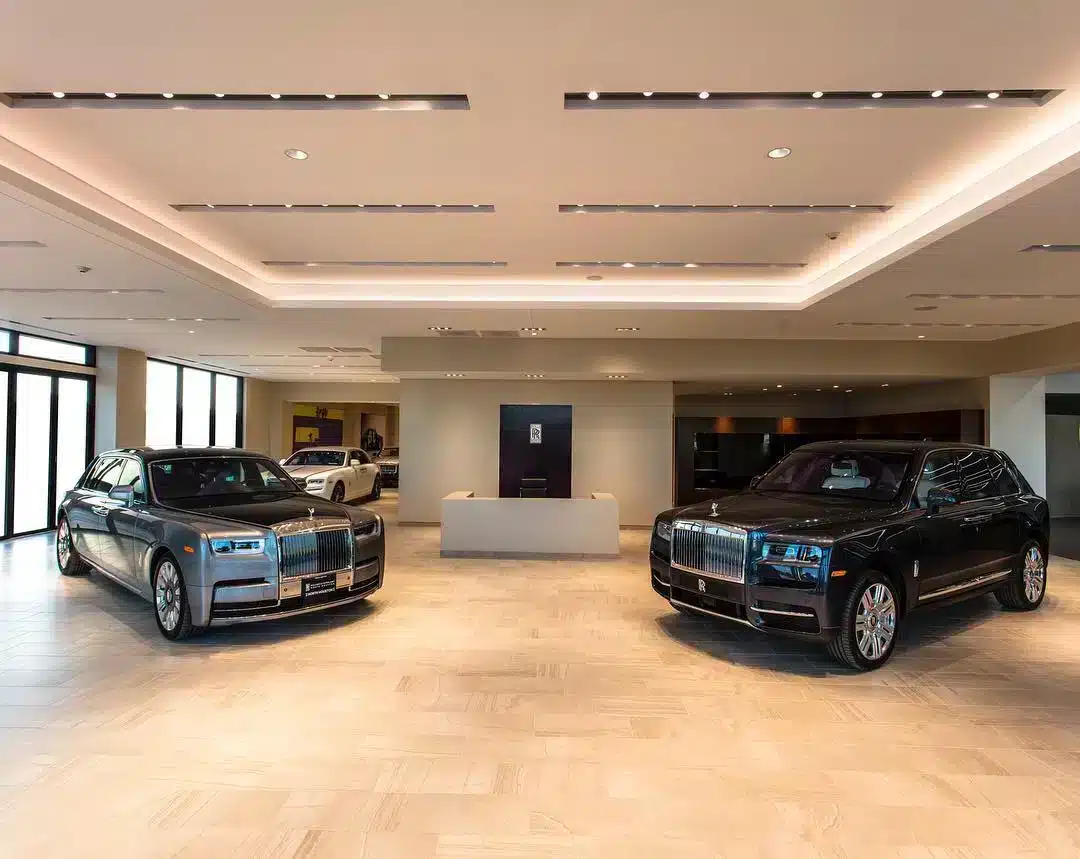Car dealerships are often recognized for their impressive designs, pristine floors, and stunning cars. Well-designed car dealership lighting is what makes everything come together. Showrooms are often large and spacious, and lighting design plays a crucial role in enhancing the aesthetic of cars, attracting customers’ attention, and ultimately increasing sales.
Here, we will provide a quick guide on the types of fixtures for car dealerships and what to keep in mind when designing your showroom lighting.
Types of Car Dealership Lighting Fixtures
Downlights: These lights are installed in the ceiling and cast a downward light. They are perfect for illuminating the entire space and highlighting key features such as cars or displays. They are often used for general lighting in the showroom. The illumination from downlights should reach approximately four feet above the ground to reach the surface of the car. Due to the very high ceilings that are typically found in showrooms, you will need a light that’s powerful enough to reach the cars, such as the Solais X-Series.
Linear Lighting (Ambient Lighting): This type of lighting is installed around the edges of the showroom, creating an even glow throughout the space. This type of lighting can be installed in a variety of configurations, such as recessed into the ceiling or mounted on walls, allowing for versatility in design.
A unique way to implement linear lighting would be to create a pathway that guides customers through the showroom. This can be particularly effective in larger dealerships with multiple display areas, and can act as a way to guide people through the dealership while creating visual interest.
Accent and Spot Lighting: These lights are used to highlight specific areas of the showroom, such as cars or displays. By using directional lighting fixtures such as track lighting, spotlights, or wall-mounted fixtures, accent lighting can be used to create dramatic effects and to emphasize specific details such as the curves or textures of a car.
Task Lighting: These lights are focused on specific tasks, such as paperwork or car maintenance. By providing adequate task lighting, dealerships can improve the productivity and accuracy of their staff, creating a more efficient and effective operation.
Considerations When Choosing Car Dealership Lighting
When selecting LED lighting for a car showroom, there are several factors to consider. One example is color temperature, which refers to the warmth or coolness of the light. For showrooms, it’s recommended to use a color temperature of around 3500K to 4500K, as this temperature enhances the colors of the cars and creates a bright and task-oriented atmosphere.
Brightness is another factor to consider. Showrooms require bright lighting, but not so bright that it creates a harsh glare. The ideal brightness for a car showroom is around 100 lux, but it’s important to adjust the brightness depending on the specific areas of the showroom and the time of day.
You should also choose LED lighting that allows for flexibility and versatility. Different types of vehicles may require different lighting approaches, with some models benefiting from accent lighting to showcase unique features, while others may require task lighting for inspections and detailing. Flexibility also allows for adjustments in response to changing layouts, such as during promotional events or seasonal changes and rotations in inventory as cars sell.
Energy efficiency is a critical consideration when choosing lighting for car showrooms because it can significantly impact operating costs and environmental sustainability. Due to their size, car showrooms typically require large amounts of lighting to create an attractive and well-lit environment, and inefficient lighting can lead to high energy bills and excessive carbon emissions. By selecting energy-efficient lighting solutions that use LED, dealerships can significantly reduce their energy consumption and associated costs.
Things to Consider When Designing the Showroom Lighting Plan
When designing a lighting plan for a car showroom, it’s important to determine the lighting goals, assess the space, select appropriate lighting fixtures, and create a lighting layout that complements the merchandise.
To achieve the best lighting balance, a combination of ambient and accent lighting should be used. Dimmer switches should also be incorporated into the lighting design to allow for easy adjustments depending on the time of day or specific lighting needs, such as promotional events.
Ultimately the goal is to drive sales, so the lighting should complement the design of the showroom and enhance the colors and textures of the cars.
Contact Solais for Consultation on LED Car Dealership Lights
Proper lighting is crucial for car showrooms as it can enhance the overall look of the cars, draw customers’ attention, and increase sales. When selecting LED lighting for a showroom, it’s important to consider factors such as color temperature, brightness, flexibility, and energy efficiency. By designing a lighting plan that combines ambient and accent lighting and complements the design of the showroom, car dealerships can create a dynamic and engaging environment that draws in customers and highlights the unique features of the vehicles on display.
Contact Solais for consultation on your car showroom lighting needs.
